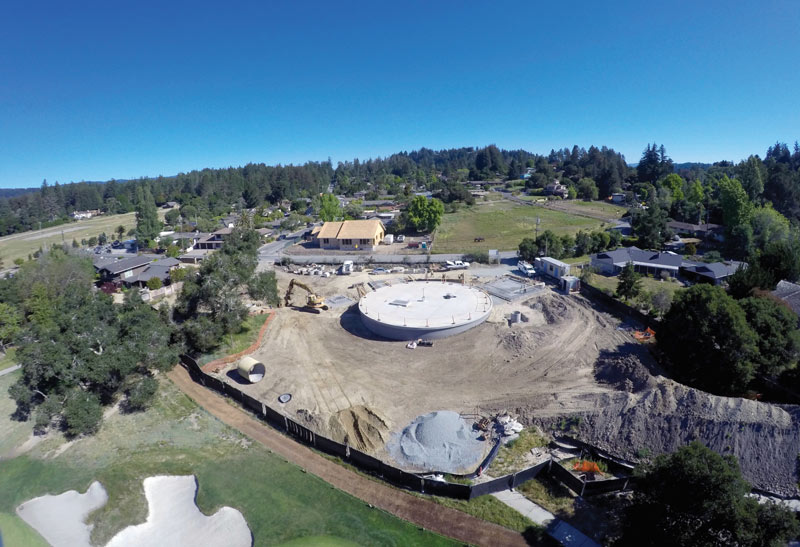
Water works: A bird’s-eye view of Pasatiempo Golf Club’s new water storage tank, water treatment facility and pump station in May. The system, which recycles treated wastewater from the nearby city of Scotts Valley, Calif., came online in September. Photo courtesy of Justin Mandon
In 1979, when a pipeline was being constructed to carry treated wastewater from the small city of Scotts Valley, Calif., about six miles south to the Monterey Bay, a thoughtful engineer anticipated that Pasatiempo Golf Club might someday want access to all that effluent passing by its property en route to the Pacific. Now, 38 years after that engineer included valve infrastructure to connect the pipeline to Pasatiempo — and following decades of discussion, droughts, and, more recently, water restrictions and rate hikes — that forethought has come to fruition.
In September, the 18-hole Alister MacKenzie treasure in Santa Cruz, Calif., began use of a new $9 million irrigation setup, which consists of a 500,000-gallon subterranean water storage tank, a water treatment facility (located largely underground as well, and which refines the wastewater an additional time before it meets landscape) and a pump station, all situated on an approximately three-quarter-acre area behind the 13th green. The system will allow the course to shift from irrigating entirely with potable (drinking-quality) water purchased from the city to what GCSAA Class A superintendent Justin Mandon says is a goal of 65 to 80 percent reclaimed water from Scotts Valley, supplemented with 10 to 20 percent each of potable water and water from an on-site well.
“It’s a unique situation, having three sources of water and having to blend them. I couldn’t find another facility that does it,” says Mandon, who has been at the agronomic helm of Pasatiempo since 2013. “We’re guaranteed that 65 percent of our water will be recycled water, and my hope is to increase that, because our cheapest source will be the recycled water.”
Although the reuse-primed water had long flowed within relatively easy reach, putting it to work keeping the golf course quenched wasn’t exactly simple. Beyond the inherent challenge of maintaining turfgrass in the Central Coast climate (“We don’t see a drop of rain from May until Halloween,” Mandon says), Pasatiempo’s long-standing reliance on city water meant it lacked many mainstays of modern golf course irrigation. “We had no storage, no tank or pond, no pump station,” Mandon says. Negotiating with multiple stakeholders (Scotts Valley, Santa Cruz and their water authorities) plus navigating regulations and permitting made pulling off the departure from potable water even more complex and snail-paced.
In 2010, Pasatiempo reduced its turfgrass acreage by about 25 percent, and installed a new irrigation system to accommodate the eventual transition to reclaimed water from Scotts Valley. The grand plan got the fast track in May 2014, though, when, in the midst of unprecedented drought in California, Santa Cruz mandated the facility cut its water use by 50 percent. Pasatiempo broke ground on its multifaceted setup in May 2016. Despite the considerable price tag, the payback period will be less than 10 years, Mandon says, because the semiprivate club was facing annual water costs of $1 million after the city raised rates by almost 40 percent in October 2014.
Completion of the project comes at a potential turning point for golf courses in California, as a bill introduced to lawmakers earlier this year pushes for statewide adoption of “direct potable reuse,” a process in which treated wastewater is purified to the standards of drinking water and then returned to the supply as such. The distinction between potable and recycled water would thus disappear, leaving golf courses that rely on recycled water in uncertain territory, possibly having to compete with other interests for the reclassified resource. Pasatiempo’s contract with Scotts Valley, however, guarantees its share of the city’s treated wastewater for the next 30 years. (Pasatiempo uses just 16 to 17 percent of the wastewater Scotts Valley sends through the pipeline, Mandon says.)
At the culmination of an irrigation initiative nearly 40 years in the making, Mandon, a 15-year GCSAA member, encourages fellow superintendents — even those in areas not presently battered by drought or bound by water restrictions — to begin pursuing and preparing for reclaimed-water options. “You need to know where your water is coming from and who runs that, and the first thing to do is to get in their office and get that relationship started so they know you, and then you can work on the pieces from there,” Mandon says. “I never thought I’d be the person who would stand in front of a crowd and do a PowerPoint presentation, but you realize at some point that no one is going to represent the golf course with more of a knowledge base than the superintendent. Start now.”
In the unique case of Pasatiempo, the “start” can be traced all the way back to a future-minded engineer who, at no one’s instruction and to no fanfare, set a classic golf course up for its latest and perhaps greatest stride toward sustainability.
Megan Hirt is GCM’s managing editor.